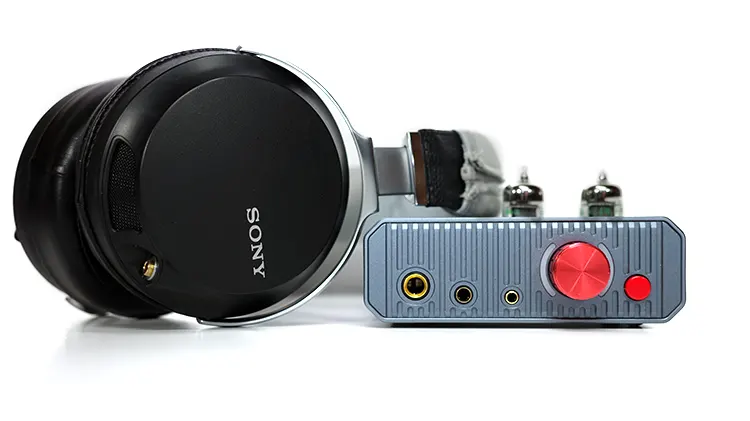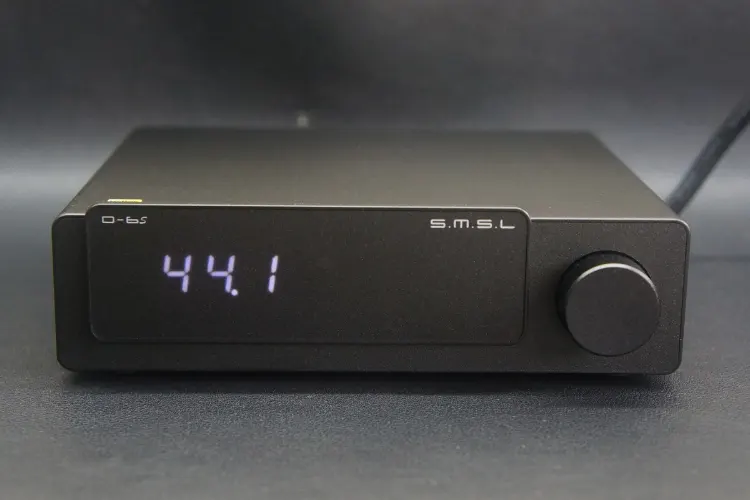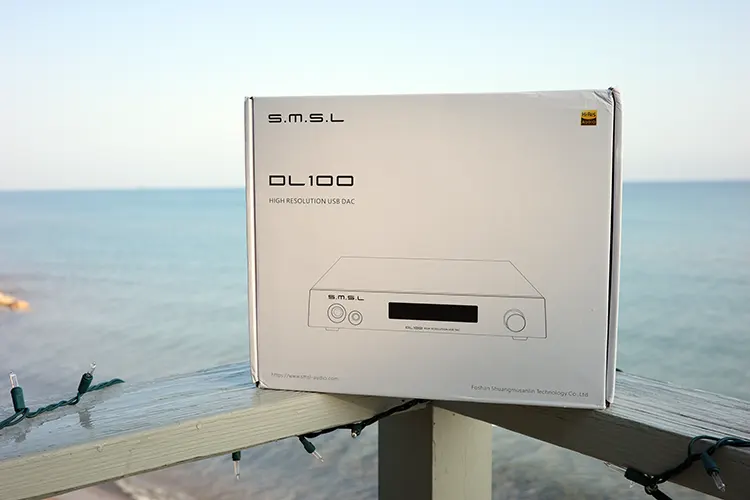Synergy
Connectivity
The SMSL DL100 worked across many different sources, including using it as the front end with my oppo BDP-83 as a CD player, the HiBy R4 as a streaming source, and my Mackbook Pro for the same purpose.
Plus, while the connection was not needed, the DL100 seamlessly connected to my Klipsch The Sixes through the optical connection.
The HDMI (ARC) connection also worked through my Samsung Smart TV, then into The Sixes, but this is probably the situation I would use the least. This does go to show the versatility of the DL100, though.
My favorite connection was the Oppo, and I spent many of the testing hours connected to it enjoying both IEMs (Spirit Torino Twin Pulse Beryllium) and headphones (Meze Audio 99 Classics).
A clear, crisp sound came forth from the duo, lacking only in deep-reaching bass. This setup stayed true to CD-level audio quality.
The HiBy R4 was connected using the USB-C connection on both ends, and the USB Audio Pro app had to be used.
Once logged in though, I could easily bring up both Tidal and Qobuz from within the app. Deeper reaching bass, and a warm, richer signature came about with this pairing, which countered the oppo’s direction nicely.
The Klipsch The Sixes connection was straightforward through the optical cable, providing a vibrant, sparkly signature; which fit the speaker’s tendency for a treble-pushing signature. Again, the countering sound signature from this hookup complimented the others mentioned.
The DL100 was proving not only its versatility but also that it worked well across all of these sources.
Efficiency
Hard-to-drive headphones will suffer, such as my 600Ω AKG240DF, but that is to be expected. Headphones such as the 350Ω FiiO FT3 suffered less, but still felt strained.
IEMs on the other hand were able to show off their mettle without bother. I do not own any seriously hard-to-drive IEMs, but those that perform at a high level such as the Spirit Torino Twin Pulse IEM were handled through the DL100 with success, just not as much as a higher-level DAC/amp could provide.
Power
The DL100 could drive the Meze Audio 99 Classics to high volume levels no matter what source I used. While some companies are conservative in their numbers, the DL100 comes across as accurate.
It is not meant to drive high-impedance headphones. The DL100 is oriented more towards lower impedance gear with the ability to seamlessly fit into your TV system or powered speakers where those items do most of the power work.
Pairings
I was able to pull out Kennerton Rognir headphones when I paired the DL100 with the Geshelli Labs Erish2 headphone amplifier (XLR headphone port only).
I found the Kennerton’s worked well using the Erish2’s power to properly drive them to not only a loud level but one with very good sound qualities, too. The DL100 worked as the DAC seamlessly in the background.
My favored pairing though was the Meze Audio 99 Classics with the ddHiFi BC-150B 4.4mm balanced cable. Queuing up a CD on the Oppo or Tidal on the R4, the sound coming forth added a bit of heft to what some describe as quality sound from the 99’s, but a bit thin.
I still thoroughly enjoy the Spirit Torino Twin Pulse IEM, pulling it out regularly for reviews and personal listening. With the DL100 and the R4, I found it worked adequately, but I did not notice as large of a jump in sound quality over the others.
This could mean that the Twin Pulse already functions at such a high level, or the pairing was moderate at best. Regardless, I still enjoyed the setup.
Select Comparisons
xDuoo MH02
Features
The xDuoo MH02 is a Class A buffered transistor headphone amplifier that uses 6J1 tubes as the pre-amplifier, warming what might be a colder, more sterile sound.
Capable of decoding up to PCM 32bit/384kHz, MQA 32bit/384kHz, & DSD256 through the USB input, the characteristics fall right in line with this level of amplifier.
Keeping the Pre-amp and amplifier separate also contains potential noise interference, especially where tubes are concerned. The MH02 isolates each to help minimize interference and potential noise pitfalls.
Providing up to 1300MW(32Ω LOAD), the MH02 drives most higher-impedance headphones, too. A single CS43131 DAC chip (as opposed to the 4 in the DL100) carries a low noise floor along with high decoding abilities.
This helps isolate any of the typical tube “ping” you might hear when touching the surfaces of the MH02 when it is turned on.
The gain switch can add either 12dB or 18dB for headphones which need a higher output to perform. Since the “normal” output most likely would be the 12dB gain, it should be considered a baseline, meaning a +6dB gain between each setting is more realistic.
With a line-out, the MH02 can be utilized as a pre-amp for those who want to add another amplifier to the chain. There is also a built-in circuit protector, avoiding that familiar “pop” when turning on a unit such as this that carries tubes.
Design
The MH02 carries a small rounded, rectangular footprint, with the two tubes sticking out of the top adding to the aura. The sandblasted aluminum shell carries “slots” to help dissipate heat giving the unit a more industrial look, especially with the gray coloring.
Carrying 12 X 7.8 X 4.0CM dimensions and a svelte weight of 0.35kg makes the unit imminently placeable within your system. The tube look will make you want to show it off, though, especially if you go tube rolling.
Performance
Tube amplifiers usually promote a smoother, warmer signature, and the MH02 follows this but with a level of detail mostly on par with a Class-A amplifier of this class.
There is plenty of power to drive higher impedance headphones with ease mostly, and I rarely had to use the high gain setting.
When using high gain though, the midrange is elevated and enhanced, pushing it to the forefront, but without losing clarity on both ends too much.
The treble reach is smoothed by the tubes, and the bass digs a bit deeper, but without the familiar elongated, thumping notes typical of a tube amplifier.
Limited by the stock tubes, the sound comes across as fairly typical of a tube amplifier, but without the overall smoothness often associated with such a unit. The sound is not nearly as detailed and clear as the DL100, but the fun here is when you change tubes, giving a different sound characteristic.
Using the NOS GE tubes I purchased specifically for the MH-02, I enjoyed the added level of detail, which the stock tubes could not match.
There was also a more organic feel to it, which fit my expectations of what a good tube amplifier can provide. So, the MH02 was just the beginning, and the fun began when I changed the tubes.
SMSL D-6S Review
Note that this comparison is DAC vs DAC using the Geshelli Labs Erish2 as a headphone amplifier.
Features
The SMSL D-6S is a dedicated desktop digital-to-analog converter with RCA and XLR outputs, as well as Bluetooth, optical, and coaxial inputs, just like the DL100.
The D-6S uses the third-generation XMOS XU-316 USB processor, providing a stable and low-latency USB connection. The XMOS chip works in unison with an ES9039Q2M, letting it decode up to PCM 32-bit/768kHz and DSD512 formats, instead of the CS43131 chips used in the DL100.
The D-6S supports Bluetooth input, specifically, Bluetooth 5.1 with wide codec support, similar to the DL100. This allows you to stream wireless audio from your smartphone, tablet, or laptop whilst minimizing wireless latency and maximizing wireless fidelity and compatibility.
The D-6S supports MQA (Master Quality Authenticated) decoding technology which is less relevant these days. Other than the chipset used and the DL100’s HMDI connection, these two are similar.
Design
The D-6S has a sleek and minimalist design that blends in aesthetically with most desktop setups. The chassis is made of aluminum alloy and has a matte black finish.
Other than the sharp corners of the front panel display, the design is user-friendly and easy to manipulate. Those edges break the otherwise plain design of the unit, but I am not a fan of its sharp edges.
The front panel has frosted plastic revealing a 7-segment LED display showing the input source, sample rate, and volume level. The only button on the front is the power button, which doubles as the input selector.
The display has a soft white backlight that is not too bright or distracting but sufficiently displays all pertinent information even in a bright room, whereas the DL100 is the typical off-blue LED with a black background.
Measuring 150x42x128.5mm and 590g, it isn’t the smallest DAC unit and will take up some desktop space, but it isn’t too large to cause any problems even in smaller dorm room setups. It is smaller than the DL100, though.
When connected to a larger home theater or TV setup, the larger size becomes a non-issue, and the D-6S will easily blend into even the most minimalist Hi-Fi setups; just like the DL100.
Performance
The D-6S has a clean, engaging timbre that does not color the overall tonal balance at all, It does not add any warmth or brightness to the sound but rather preserves its original tonality while adding some excitement via its good dynamics.
The difference here is that the DL100 takes on the persona of the source a bit more but does carry an engaging personality.
Low-end bass drum hits are not given additional weight and bass riffs do not bleed into the lower mids. Despite this, deep male vocals do not sound hollow due to the DAC’s good extension towards the low end.
Bass hits have a strong impact and good texture. The difference in texture was quite noticeable compared to other less capable DACs, mirroring the results of the DL100.
The mid-range was neutral but exciting. String instruments are well articulated and textured, and vocal performances are presented in a way that maintains all nuance.
Once again, the sheer texture playback was the immediate standout to me. The slightly forward nature of the DL100’s mids separates itself from the D-6S here. High-pitched female vocals are presented with a slight sparkle, giving a better sense of detail. The treble region is presented in a very detailed manner.
Different cymbal strikes can be easily differentiated from one another, but it does not introduce any sibilance in its presentation. The DL100 is not as precise on that separation in the treble range.
Snare drums sounded full and nuanced, compared to the compressed “crunchy” snare drum playback I observed in more affordable DACs.
The performance levels of the D-6S is above the DL100, except for what I might call the “fun factor.”.
My Verdict
Going into this review, I had expectations for the DL100: provide a competent platform and sound fitting of the range. What surprised me was the versatility with which the DL100 slid into pretty much any source I connected.
The SMSL DL100 can connect pretty much anything you can throw at it from powered speakers to DAPs to CD players. It does so without fuss in an ordinary manner that would be a competent starting point for many. Or as part of a home’s sub-system which sees more use than many of us care to admit.
The DL100 is a good choice if you are looking at its versatility but put overall sound secondary to that equation. That said, it functioned better than I expected and I came away impressed and surprised.
SMSL DL100 Technical Specifications
- Chipset: 4x CS43131, 3x high-end dual op amp OPA1612a
- Supported Formats: PCM up to 32bit/768kHz, DSD up to DSD256
- Input: USB/Optical/Coaxial/Bluetooth/HDMI(ARC)
- Output level: RCA 2.5 Vrms XLR 5.2 Vrms HPA 7.5 Vrms
- Output impedance: LINE OUT 100Ω HP OUT Near 0Ω
- Headphone output power: 3.0W×2 @ 16Ω, 1.5W×2 @ 32Ω
- THD+N(non-Weighting): LINE OUT 0.00009%(-120dB) HP OUT 0.0001%(-115dB)
- Dynamic range: RCA 126dB XLR 132dB HPA 126dB
- SNR: RCA 126dB XLR 132dB HPA 126dB
- Bluetooth specification: 5.1(Support SBC, AAC, aptX, aptX HD,LDAC)
- USB transmission: Asynchronization
- USB compatibility: Windows 7 / 8 / 8.1 / 10 / 11 / Mac OSX10.6 or Later 、Linux
- Bit Depth: USB 1bit, 16~32bit Optical / Coaxial 1bit, 16~24bit
- Sampling rate: USB PCM 44.1~768kHz DSD 2.8224~11.2896MHz Optical / Coaxial PCM 44.1~192kHz DSD DSD64(DoP)
- Power Consumption: <30W
- Standby power: <0.5W
- Size: 196x31x206mm (WxHxD)
- Weight: 1.05Kg/2.31lbs





